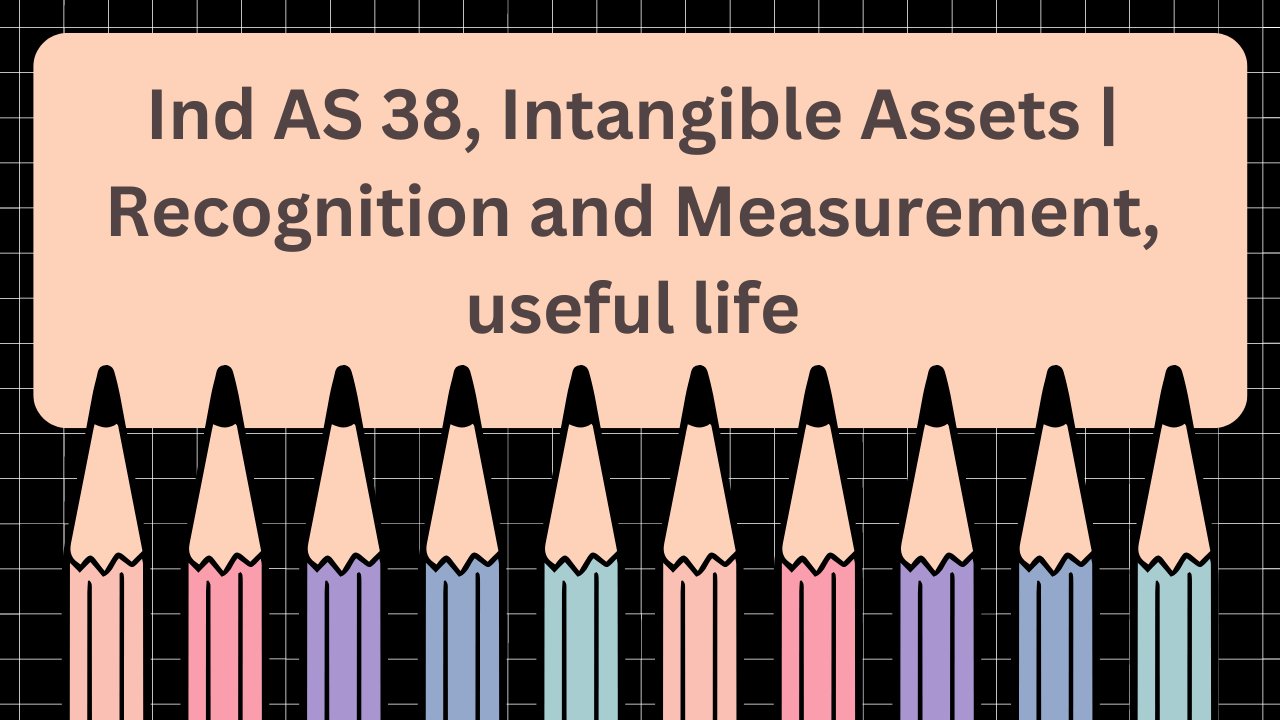Ind AS 38, Intangible Assets: The objective of Ind AS 38 is to prescribe the accounting treatment for intangible assets that are not dealt with specifically in another Standard. This Standard requires an entity to recognize an intangible asset if, and only if, specified criteria are met. The Standard also specifies how to measure the carrying amount of intangible assets and requires specified disclosures about intangible assets. An intangible Asset is an identifiable non-monetary asset without physical substance. Must Check Lease Definition.
Quick Links
Recognition and Measurement
An intangible asset should be recognized in the financial statements as an intangible asset if it meets the definition of an intangible asset and meets both the recognition criteria mentioned below.
An intangible asset should be recognized if, and only if:
- it is probable that the expected future economic benefits that are attributable to the asset will flow to the entity, and
- the cost of the asset can be measured reliably. An intangible asset should be measured initially at
An entity should assess the probability of expected future economic benefits using reasonable and supportable assumptions that represent management’s best estimate of the set of economic conditions that will exist over the useful life of the asset.
Separate Acquisition
The cost of a separately acquired intangible asset would comprise:
- its purchase price, including import duties and non-refundable purchase taxes, after deducting trade discounts and rebates; and
- any directly attributable cost of preparing the asset for its intended use.
Acquisition as Part of a Business Combination
In accordance with Ind AS 103, Business Combinations, if an intangible asset is acquired in a business combination, the cost of that intangible asset is its fair value at the acquisition date. If an asset acquired in a business combination is separable or arises from contractual or other legal rights, sufficient information would exist to measure reliably the fair value of the asset.
In accordance with this Standard and Ind AS 103, an acquirer should recognize at the acquisition date, separately from goodwill, an intangible asset of the acquiree, if it meets the definition and recognition criteria for an intangible asset irrespective of whether the asset had been recognized by the acquiree before the business combination. This means that the acquirer recognizes as an asset separately from goodwill an in-process research and development project of the acquiree if the project meets the definition of an intangible asset. You may also like Deferred Revenue Expenditure.
Internally Generated Intangible Assets
Internally generated goodwill shall not be recognized as an asset.
No intangible asset arising from research should be recognized. Expenditure on research (or on the research phase of an internal project) should be recognized as an expense when it is incurred.
An intangible asset arising from development shall be recognized if, and only if, an entity can demonstrate all of the following:
- the technical feasibility of completing the intangible asset so that it will be available for use or
- its intention to complete the intangible asset and use or sell (c) its ability to use or sell the intangible asset.
- how the intangible asset will generate probable future economic benefits.
- the availability of adequate technical, financial, and other resources to complete the development and to use or sell the intangible
- its ability to measure reliably the expenditure attributable to the intangible asset during its
Internally generated brands, mastheads, publishing titles, customer lists and items similar in substance should not be recognized as intangible assets.
The cost of an internally generated intangible asset is the sum of expenditure incurred from the date when the intangible asset first meets the recognition criteria and the condition relating to the development phase. Ind AS 38 prohibits reinstatement of expenditure previously recognized as an expense.
Recognition of an Expense
Expenditure on an intangible item should be recognized as an expense when it is incurred unless:
- it forms part of the cost of an intangible asset that meets the recognition criteria, or the item is acquired in a business combination and cannot be recognized as an intangible asset. If this is the case, it forms part of the amount recognized as goodwill at the acquisition date (see Ind AS 103).
Measurement after recognition
An entity should choose either the cost model or the revaluation model as its accounting policy. If an intangible asset is accounted for using the revaluation model, all the other assets in its class should also be accounted for using the same model, unless there is no active market for those assets.
Cost Model- After initial recognition, an intangible asset should be carried at its cost less any accumulated amortization and any accumulated impairment losses.
Revaluation Model- After initial recognition, an intangible asset shall be carried at a revalued amount, being its fair value at the date of the revaluation less any subsequent accumulated amortization and any subsequent accumulated impairment losses. For the purpose of revaluations under this Standard, fair value shall be measured by reference to an active market. Revaluations shall be made with such regularity that at the end of the reporting period the carrying amount of the asset does not differ materially from its fair value
The revaluation model is applied after an asset has been initially recognized at cost. However, if only part of the cost of an intangible asset is recognized as an asset because the asset did not meet the criteria for recognition until part of the way through the process, the revaluation model may be applied to the whole of that asset. Must Check Classification of Errors.
Treatment of Revaluation Gains and Losses
If an intangible asset’s carrying amount is increased as a result of a revaluation, the increase should be recognized in other comprehensive income and accumulated in equity under the heading of revaluation surplus. However, the increase should be recognized in profit or loss to the extent that it reverses a revaluation decrease of the same asset previously recognized in profit or loss.
If an intangible asset’s carrying amount is decreased as a result of a revaluation, the decrease should be recognized as profit or loss. However, the decrease should be recognized in other comprehensive income to the extent of any credit balance in the revaluation surplus in respect of that asset.
Useful Life
Useful life is:
- the period over which an asset is expected to be available for use by an entity; or
- the number of production or similar units expected to be obtained from the asset by an
The accounting for an intangible asset is based on its useful life. An intangible asset with a finite useful life is amortized, and an intangible asset with an indefinite useful life is not.
Many factors are considered in determining the useful life of an intangible asset.
Review of Useful Life Assessment
The useful life of an intangible asset that is not being amortized should be reviewed each period to determine whether events and circumstances continue to support an indefinite useful life assessment for that asset. If they do not, the change in the useful life assessment from indefinite to finite should be accounted for as a change in an accounting estimate in accordance with Ind AS 8.
Derecognition
An intangible asset shall be derecognized:
- a) on disposal; or
- b) when no future economic benefits are expected from its use or disposal.
The gain or loss arising from the derecognition of an intangible asset shall be determined as the difference between the net disposal proceeds, if any, and the carrying amount of the asset. It shall be recognized in profit or loss when the asset is derecognized (unless Ind AS 116 requires otherwise on a sale and leaseback). Gains shall not be classified as revenue.
The disposal of an intangible asset may occur in a variety of ways (e.g. by sale, by entering into a finance lease, or by donation). The date of disposal of an intangible asset is the date that the recipient obtains control of that asset in accordance with the requirements for determining when a performance obligation is satisfied in Ind AS 115, Revenue from Contracts with Customers. Ind AS 116 applies to disposal by a sale and leaseback
Appendix A of Ind AS 38 provides guidance on whether the website is an internally generated intangible asset that is subject to the requirements of Ind AS 38; and the appropriate accounting treatment of such expenditure. The Appendix prescribes that an entity’s own website that arises from development and is for internal or external access is an internally generated intangible asset that is subject to the requirements of Ind AS 38. Any internal expenditure on the development and operation of an entity’s own website shall be accounted for in accordance with Ind AS 38.
The nature of each activity for which expenditure is incurred (eg training employees and maintaining the website) and the website’s stage of development or post-development shall be evaluated to determine the appropriate accounting treatment. A website that is recognized as an intangible asset under this Appendix shall be measured after initial recognition by applying the requirements of paragraphs 72-87 of Ind AS 38. The best estimate of a website’s useful life should be short.
Recommended







